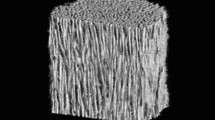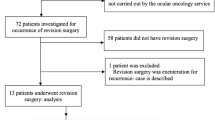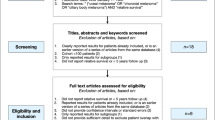Abstract
Purpose
To evaluate bovine pericardium (Tutopatch®) as a wrapping material for hydroxyapatite implants in patients undergoing enucleation for uveal melanoma.
Method
Prospective cohort study of patients who had enucleation for uveal melanoma between January 2003 and August 2003 were included in the study. Any patient with less than 3 months follow-up was excluded. Enucleation was performed under general anaesthesia followed by insertion of hydroxyapatite implants wrapped in bovine pericardium (Tutopatch). The recti muscles were sutured directly to the wrap. The tenon's capsule and conjunctiva were closed in two layers. A conformer was inserted at 1 week and artificial eye at 2–3 months. The patients were followed up regularly and were assessed for cosmetic result, exposure of implant, and the need for any further surgical procedures.
Results
A total of 19 patients (seven male and 12 female) were included in the study. Median age at diagnosis was 63 years (range 38–80 years). Median follow-up was 26 months (range 22–30 months). No patient developed postoperative complications of wound dehiscence. The overall cosmetic result was excellent in all the patients. The rate of postoperative complications compared favourably with published data using other wrapping materials/implants.
Conclusion
Tutopatch® is a safe wrapping material for hydroxyapatite orbital implants in patients undergoing enucleation for uveal melanoma.
Similar content being viewed by others
Log in or create a free account to read this content
Gain free access to this article, as well as selected content from this journal and more on nature.com
or
References
Mules PH . Eviceration of the globe with artificial vitreous: 1884–1894. Adv Ophthalmic Plast Reconstr Surg 1990; 8: 69–72.
Shields JA, Shields CL, De Potter P . Hydroxyapatite orbital implant after enucleation—experience with 200 cases. Mayo Clin Proc 1993; 68: 1191–1195.
Chen X, Gao D, Yin S . Application of polyester fiber heart patches to secondary intraorbital implantation of hydroxyapatite spheres. Zhonghua Zheng Xing Wai Ke Za Zhi 2000; 16: 270–272.
Kao SC, Chen S . The use of rectus abdominis sheath for wrapping of the hydroxyapatite orbital implants. Ophthal Surg Laser 1999; 30: 69–71.
Naugle Jr TC, Lee AM, Haik BG, Callahan MA . Wrapping hydroxyapatite orbital implants with posterior auricular muscle complex grafts. Am J Ophthalmol 1999; 128: 495–501.
Jordan DR, Klapper SR, Gilberg SM . The use of vicryl mesh in 200 porous orbital implants: a technique with few exposures. Ophthal Plast Reconst Surg 2003; 19: 53–61.
Gayre GS, Debacker C, Lipham W . Bovine pericardium as a wrapping for orbital implants. Ophthal Plast Reconstr Surg 2001; 17: 381–387.
Custer PL . Enucleation: past, present, and future. Ophthal Plast Reconst Surg 2000; 16: 316–321.
Char DH . Early wound dehiscence with use of hydroxyapatite orbital implant covered with calf pericardium. Br J Ophthalmol 2001; 85: 627–628.
Shields CL, Shields JA, De Potter P . Hydroxyapatite orbital implant after enucleation. Experience with initial 100 consecutive cases. Arch Ophthalmol 1992; 110: 333–338.
Inkster CF, Ng SG, Leatherbarrow B . Primary banked scleral patch graft in the prevention of exposure of hydroxyapatite orbital implants. Ophthalmology 2002; 109: 389–392.
Arat YO, Shetlar DJ, Boniuk M . Bovine pericardium vs homologous sclera as a wrapping for hydroxyapaptite orbital implants. Ophthal Plastic Reconstr Surg 2003; 19 (3): 189–193.
Seiff SR, Chang Jr JS, Hurt MH, Khayam-Bashi H . Polymerase chain reaction identification of human immunodeficiency visus-1 in preserved human sclera. Am J Ophthalmol 1994; 118: 528–529.
Nunery WR . Risk of prion transmission with the use of xenografts and allografts in surgery. Ophthal Plast Reconstr Surg 2001; 17: 389–394.
Filippi R, Schwarz M, Voth D, Reisch R, Grunert P, Perneczky A . Bovine pericardium for duraplasty: clinical results in 32 patients. Neurosurg Rev 2001; 24: 103–107.
Oestreicher JH, Liu E, Berkowitz M . Complications of hydroxyapatite orbital implants: a review of 100 consecutive cases and a comparison of Dexon mesh (polyglycolic acid) with scleral wrapping. Ophthalmology 1997; 104: 324–329.
Author information
Authors and Affiliations
Corresponding author
Rights and permissions
About this article
Cite this article
Gupta, M., Lyon, F., Singh, A. et al. Bovine pericardium (Tutopatch) wrap for hydroxyapatite implants. Eye 21, 476–479 (2007). https://doi.org/10.1038/sj.eye.6702227
Received:
Accepted:
Published:
Issue date:
DOI: https://doi.org/10.1038/sj.eye.6702227
Keywords
This article is cited by
-
Tendon elongation with bovine pericardium in strabismus surgery—indications beyond Graves’ orbitopathy
Graefe's Archive for Clinical and Experimental Ophthalmology (2021)
-
Unwrapped hydroxyapatite orbital implants: our experience in 347 cases
Eye (2020)
-
Solid Platelet Rich Plasma in Corneal Surgery
Ophthalmology and Therapy (2016)
-
Defektdeckung eines perforierten Hornhautulkus mit einem bovinen Perikardtransplantat
Der Ophthalmologe (2014)
-
Complications due to bovine pericardium used to cover acrylic implants after enucleation and tubes of aqueous devices
Eye (2012)



